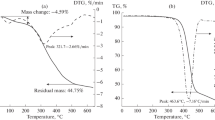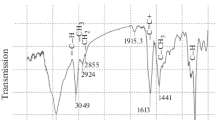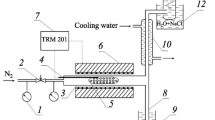Abstract
The compositional and structural changes that coal asphaltenes undergo with increasing thermal maturation were investigated using solid-state 13C NMR and Fourier transform infrared spectroscopy. The results show a gradual increase in the relative proportion of carbon content with a concomitant decrease in the hydrogen, sulphur and oxygen content. The amount of aromatic carbon also increases while the aliphatic carbon decreases with increasing maturity. Ester and carboxylic groups are particularly sensitive to maturation and decrease in relative abundance with increasing maturity while the amount of aromatic carbonyl groups increases. In general, the asphaltenes were observed to evolve towards a more thermally stable structure with increasing amounts of aromatic moieties and relatively lower amounts of aliphatic moieties. The results are in agreement with the ultimate dominance of the island molecular architecture (the Yen–Mullins model) in asphaltenes.




Similar content being viewed by others
References
Alboudwarej H, Beck J, Svrcek WY, Yarranton HW, Akbarzadeh K (2002) Sensitivity of asphaltene properties to separation techniques. Energy Fuels 16(2):462–469
Alvarez-Ramírez F, Ruiz-Morales Y (2013) Island versus archipelago architecture for asphaltenes: polycyclic aromatic hydrocarbon dimer theoretical studies. Energy Fuels 27(4):1791–1808
Andrews AB, Edwards JC, Pomerantz AE, Mullins OC, Nordlund D, Norinaga K (2011) Comparison of coal-derived and petroleum asphaltenes by 13C nuclear magnetic resonance, DEPT, and XRS. Energy Fuels 25(7):3068–3076
Badre S, Goncalvesa CC, Norinagab K, Gustavsona G, Mullins OC (2006) Molecular size and weight of asphaltene and asphaltene solubility fractions from coals, crude oils and bitumen. Fuel 85:1–11
Baxby M, Patience RL, Bartle KD (1994) The origin and diagenesis of sedimentary organic nitrogen. J Pet Geol 17(2):211–230
Behar F, Pelet R, Roucache J (1984) Geochemistry of asphaltenes. Org Geochem 6:587–595
Buch L, Groenzin H, Buenorostro-Gonzalez E, Andersen SI, Lira-Galeana C, Mullins C (2003) Effect of hydrotreatment on asphaltene fractions. Fuel 82:1075–1084
Bunger JW, Li NC (eds) (1981) Chemistry of Asphaltenes, Advances in chemistry series 195, American Chemical Society, Washington D.C, p 260
Calemma V, Iwanski P, Nali M, Scotti R, Montanari L (1995) Structural characterization of asphaltenes of different origins. Energy Fuels 9(2):225–230
del Rio JC, Martin F, Gonzalez-Vila FJ, Verdejo T (1995) Chemical structural investigation of asphaltenes and kerogens by pyrolysis-methylation. Org Geochem 23(11–12):1009–1022
Dutta Majumdar R, Gerken M, Mikula R, Hazendonk P (2013) Validation of the Yen-Mullins model of athabasca oil-sands asphaltenes using solution-state 1H NMR relaxation and 2D HSQC spectroscopy. Energy Fuels 27(11):6528–6537
Galoppini M (1994) Asphaltene deposition monitoring and removal treatments: an experience in ultra deep wells. In: SPE Paper 27622 p 10
Groenzin H, Mullins OC (1999) Asphaltene molecular size and structure. J Phys Chem A 103(50):11237–11245
Guiliano M, Mille G, Doumenq P, Kister J, Muller JF (1990) Study of various rank french demineralized coals and maceral concentrates: band assignment of FTIR spectra afetr resolution enhancement using fourier deconvolution. In: Charcosset H (ed) advanced methodologies in coal characterisation (coal science and technology). Elsevier, Amsterdam, pp 399–417
Hammami A, Chang-Yen D, Nighswander JA, Stange E (1995) An experimental study of the effect of paraffinic solvents on the onset and bulk precipitation of asphaltenes. Fuel Sci Technol Int 13(9):1167–1184
Ibarra JV, Muñoz E, Moliner R (1996) FTIR study of the evolution of coal structure during the coalification process. Org Geochem 24(6–7):725–735
Khadim M, Sarbar M (1999) Role of asphaltene and resin in oil field emulsion. J Pet Sci Eng 23:213–221
Kokal SL, Sayegh SG (1995) Asphaltenes: the cholesterol of petroleum. In: SPE paper 29787. pp 169–81
Ma A, Zhang S, Zhang D (2008) Ruthenium-ion-catalyzed oxidation of asphaltenes of heavy oils in Lunnan and Tahe oilfields in Tarim Basin, NW China. Org Geochem 39(11):1502–1511
Maddams WF (1980) The scope and limitations of curve fitting. Appl Spectrosc 34:245–267
Mojelsky TW, Ignasiak TM, Frakman Z, McIntyre DD, Lown EM, Montgomery DS, Strausz OP (1992) Structural features of Alberta oil sand bitumen and heavy oil asphaltenes. Energy Fuels 6(1):83–96
Muhammad AB, Abbott GD (2013) The thermal evolution of asphaltene-bound biomarkers from coals of different rank: a potential information resource during coal biodegradation. Int J Coal Geol 107:90–95
Mullins OC (2009) Rebuttal to Strausz et al. regarding time-resolved fluorescence depolarization of asphaltenes. Energy Fuels 23:2845–2854
Mullins OC, Sabbah H, Eyssautier J, Pomerantz AE, Barré L, Andrews AB, Ruiz-Morales Y, Mostowfi F, McFarlane R, Goual L, Lepkowicz R, Cooper T, Orbulescu J, Leblanc RM, Edwards J, Zare RN (2012) Advances in asphaltene science and the yen-mullins model. Energy Fuels 26(7):3986–4003
Nakanishi K (1962) Infrared absorption spectroscopy. Nankodo Co Ltd, Tokyo, p 233
Painter PC, Snyder RW, Starsinic M, Coleman MM, Kuehn DW, Davis A (1981) Concerning the application of FT-IR to the study of coal: a critical assessment of band assignments and the application of spectral analysis programs. Appl Spectrosc 35:475–485
Peng P, Morales-Izquierdo A, Hogg A, Strausz OP (1997) Molecular structure of athabasca asphaltene: sulfide, Ether, and Ester Linkages. Energy Fuels 11(6):1171–1187
Peng P, Fu J, Sheng G, Morales-Izquierdo A, Lown EM, Strausz OP (1999) Ruthenium-ions-catalyzed oxidation of an immature asphaltene: structural features and biomarker distribution. Energy Fuels 13(2):266–277
Peters KE (1986) Guidelines for evaluating petroleum source rock using programmed pyrolysis. AAPG Bull 70:318–329
Rouxhet PG, Robin PL, Nicaise G (1980) Characterization of kerogens and their evolution by infrared spectroscopy. In: Durand B (ed) Kerogen: Insoluble organic matter from sedimentary rocks. Technip, Paris, pp 163–190
Sabbah H, Morrow AL, Pomerantz AE, Mullins OC, Tan X, Gray MR, Azyat K, Tykwinski RR, Zare RN (2010) Comparing laser desorption/laser ionization mass spectra of asphaltenes and model compounds. Energy Fuels 24(6):3589–3594
Sabbah H, Morrow AL, Pomerantz AE, Zare RN (2011) Evidence for island structures as the dominant architecture of asphaltenes. Energy Fuels 25(4):1597–1604
Shedid SA, Zekri AY (2006) Formation damage caused by simultaneous sulfur and asphaltene deposition. In: SPE paper 86553. pp 58–64
Sheu EY (2002) Petroleum asphaltene-propertiesm, characterization, and issues. Energy Fuels 16(1):74–82
Sheu EY, Mullins OC (eds) (1995) Asphaltenes: fundamentals and applications. Plenum Press, New York, p 245
Socrates G (1980) Infrared characteristic group frequencies: tables and charts, 2nd edn. Wiley, Chichester, p 249
Solli H, Leplat P (1986) Pyrolysis-gas chromatography of asphaltenes and kerogens from source rocks and coals–a comparative structural study. Org Geochem 10(1–3):313–329
Speight JG (2004) Petroleum asphaltenes—Part 1: asphaltenes, resins and the structure of petroleum. Oil Gas Sci Technol 59(5):467–477
Strausz OP, Mojelsky TW, Lown EM, Kowalewski I, Behar F (1999) Structural features of boscan and duri asphaltenes. Energy Fuels 13(2):228–247
Strausz OP, Safarik I, Lown EM, Morales-Izquierdo A (2008) A critique of asphaltene fluorescence decay and depolarization-based claims about molecular weight and molecular architecture. Energy Fuels 22(2):1156–1166
Trifilieff S, Sieskind O, Albrecht P (1992) Biological markers in petroleum asphaltenes: possible mode of incorporation. In: Moldowan JM, Albrecht P, Philp RP (eds) Biological markers in sediments and petroleum. Prentice Hall, New Jersey, pp 350–369
Weinberg VA, Yen TF, Murphy PDB, Gerstein BC (1983) Hypothetical average structures of two coal liquid asphaltenes from solid state 13 C nuclear magnetic resonance and 1 H nuclear magnetic resonance data. Carbon 21(2):149–156
William S (1985) Coal asphaltenes: a review. Fuel Process Technol 10(3):209–238
Wilson MA, Vassallo AM (1985) Developments in high-resolution solid-state13C NMR spectroscopy of coals. Org Geochem 8(5):299–312
Wilson MA, Pugmire RJ, Karas J, Alemany LB, Woolfenden WR, Grant DM, Given PH (1984) Carbon distribution in coal and coal macerals by cross-polarization magic angle spinning carbon-13 nuclear magnetic resonance spectroscopy. Anal Chem 56(933):43
Wu Q, Pomerantz AE, Mullins OC, Zare RN (2013) Laser-based mass spectrometric determination of aggregation numbers for petroleum- and coal-derived asphaltenes. Energy Fuels 28(1):475–482
Yen TF (1974) Structure of petroleum asphaltene and its significance. Energy Sources 1:447–463
Yen TF, Wu WH, Chilingar GV (1984) A study of the structure of petroleum asphaltenes and related substances by infrared spectroscopy. Energy Sources Part A 7(3):203–235
Acknowledgments
The author is grateful to Dr. Geoff Abbott, Newcastle University, for supervising the work, Dr. Claire Fialips formerly School of Civil Engineering & Geosciences, Newcastle University, UK for technical assistance and Dr. David Apperley and Mr. Fraser Markwell of Solid-state NMR Service at Durham University, UK for solid-state 13C NMR analysis. The author would like to thank Petroleum Technology Development Fund (PTDF), Nigeria for Ph.D scholarship.
Author information
Authors and Affiliations
Corresponding author
Rights and permissions
About this article
Cite this article
Muhammad, A.B. Thermal evolution of aliphatic and aromatic moieties of asphaltenes from coals of different rank: possible implication to the molecular architecture of asphaltenes. Chin. J. Geochem. 34, 422–430 (2015). https://doi.org/10.1007/s11631-015-0041-y
Received:
Revised:
Accepted:
Published:
Issue Date:
DOI: https://doi.org/10.1007/s11631-015-0041-y




